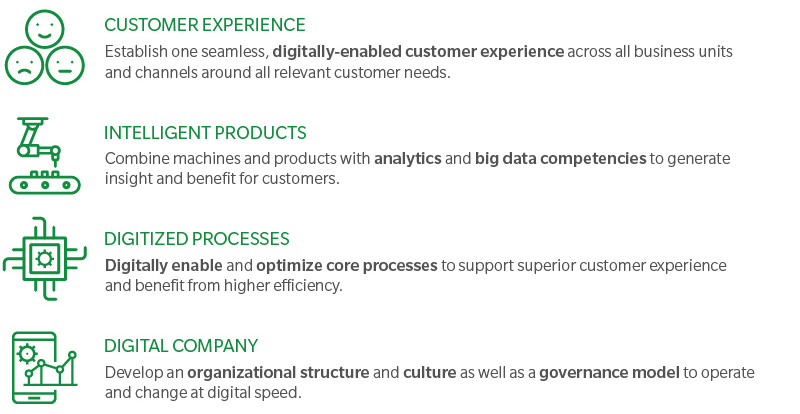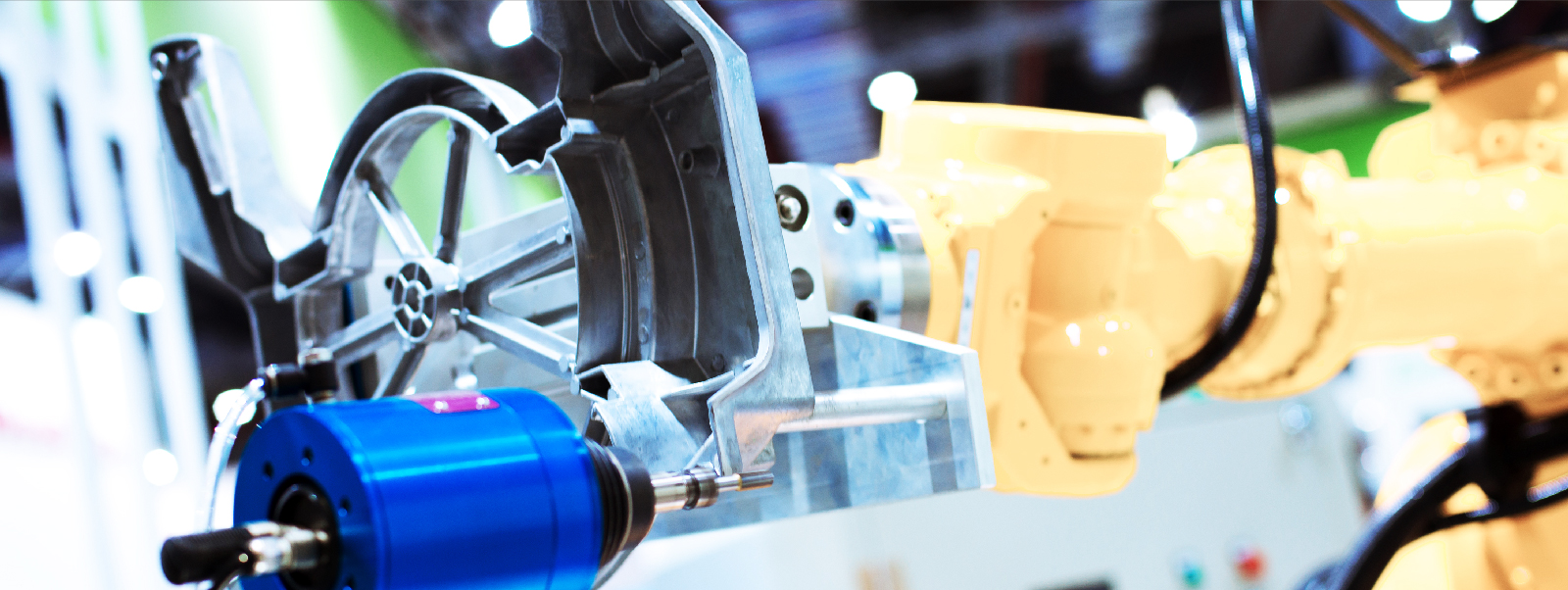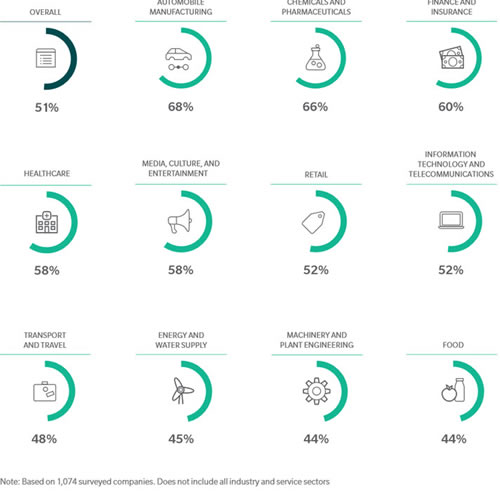Industrial firms often struggle to find the right talent to push digital initiatives, given their rigid organizational structures. Even after a digital service is established, they have a hard time shutting down existing structures and channels, such as the online sales channel versus existing dealer structures. To prepare for a digital “new normal” and maintain a leadership position, industrial companies need to initiate a robust digital transformation.
Having watched other sectors being hit by the digital wave, manufacturing is only now experiencing digitization as the primary driver of change. As the world becomes ever more connected – the number of Internet of Things (IoT) devices is expected to increase by 250 percent by 2020, to more than 8 billion – and with new technologies finding their way into industrial operations, a “new normal” is emerging. The new business environment will be dominated by ecosystems that enable multiple producers and business-to-business (B2B) customers to connect. To compete in the future, manufacturers must digitize their processes.
8 billion Internet of Things devices expected by 2020.
Thus far, firefighting and ad-hoc management has been the industrial sector’s modus operandi, especially at the manufacturing-end of the value chain. The best way forward is for manufacturers to rethink their ways of working, their structures, and how they steer their daily work. Digitization can help with instituting best practices, such as launch management, and advanced analytics can increase process maturity and boost productivity.
Industrial companies can only maintain leadership in this more digitalized environment if they undertake comprehensive transformation and address four strategic areas. First, they need to address and understand customers’ key challenges, and second they need to develop intelligent products to help solve B2B customer issues. Third, companies must radically digitize their processes. With B2B customers expecting high quality reliability standards, high-tech component manufacturers will have to modernize their inspection processes with advanced analytics and machine learning. Ultimately, as a fourth step, industrials need to become scalable, agile, and digital.
It is crucial that manufacturers undertake digitization in a way that enables rapid responses to customer needs, ensuring consistent customer experiences across all business units, products, and channels. This means selecting sustainable and scalable technology.
Industrial companies need to alter their business models and enterprises in a structured way, defining a shared target picture and identifying impactful digital initiatives. A dedicated digital organization will need to be set up, and effective steering mechanisms as well as further key enablers, such as cybersecurity, need to be implemented that pave the way for further transformations.
Drawing A Target Picture
A first step is to draw up a target picture of the results desired from the transformation, and share it throughout the organization. Define each business unit’s priorities, covering not just new, digital products, but also functions and processes that could be strengthened by digitization, such as in sales or indirect production. Review existing initiatives to come up with a clear agenda for transformation and prioritize the most important initiatives. Industrials need to examine where digitization yields the greatest value and find an effective balance of product and process initiatives.
Classifying Digital Initiatives
To get things going, firms must first identify initiatives with the potential for closing the digital gap, and push them as priorities. This ensures that key areas are addressed and have an impact on digitization goals. In the case of new digital products, for example, identifying what is most impactful requires understanding customers’ needs throughout their journey. Companies first must examine which customer needs they are not addressing, what competitors are doing to meet those needs, and then prioritizing the ones that can be quickly implemented. In digitizing manufacturing processes, it requires examining concrete use cases, including the applicability and business case of a given digitized process.
Based on this approach, a high-tech company defined a comprehensive road map for a digital integrated customer interaction product and laid out a sprint plan in only two months. The firm analyzed key manufacturing support functions and identified 10 high priority initiatives, including a mobile maintenance app Copyright © Oliver Wyman 3 for equipment documentation and a "digital shift book". These changes yielded immediate improvements in customer interaction and production uptime.
True digital transformation, however, requires going beyond such lighthouse projects and recognizing the greatest inhibitors to substantial change. While institutionalizing rapid scalable development of digital products calls for a clear digital operating model, another key is ensuring information security.
Creating Independent Digital Units
In their simplest form, digital organizations consist of guidelines and a standardsetting function specifying how business units should implement digital. In a more ambitious setting, however, they can be empowered to consolidate digital ambitions across business units and push initiatives to maturity. The latter holds out the greatest promise, enabling agile development at speed and at scale.
Digital units can then be equipped with dedicated staff and competence centers, providing agile, cross-functional product teams to ensure quick time to market. An independent digital IT function would provide standards and technical infrastructure. Business units would be represented through digital product owners that operate at the interface between business and scrum teams taking over product responsibility.
Digitized operations need to define governance and operations principles, clarify how personnel collaborate, and promote a dynamic culture and mindset – across traditional functional setups. This establishes the digital unit’s basic structure so that it benefits industrial companies.
Digitizing an industrial company is not simple. It involves rethinking established structures, processes, and steering mechanisms. But for industrials that want to remain competitive and flourish under the “new normal,” the time for developing digital transformation programs is now.
Digitization agenda for manufacturers

Source: Oliver Wyman
About Authors
Juergen Reiner is a Munich-based partner in Oliver Wyman’s Automotive and Manufacturing Industries practice and focused on technology-enabled innovation and digital transformation. Florian Deter is a Munich-based partner in Oliver Wyman’s Digital, Technology and Analytics practice and focused on digital implementation and IT programs. Hendrik Vedder is a Munich-based principal in Oliver Wyman’s Automotive and Manufacturing Industries practice and focused on digital governance and operating models.










